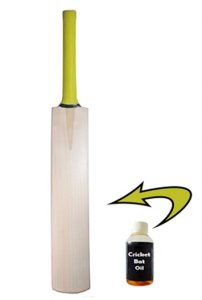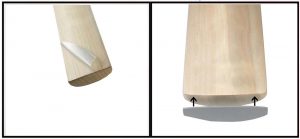Buying a new cricket bat is always an exciting thing for a cricket player, especially for a batsman. Cricket bats are made of either Kashmir willow or English willow and these bats are manufactured naturally. Most of the cricket bats are not in ‘ready to use’ condition due to the traditional manufacturing process; hence require adequate care and further preparation.
There are chances that the lifespan of a cricket bat does not illustrate a definite timeframe if it is not prepared well. New cricket bats that are not in ‘ready to use’ condition, needs a proper preparation like oiling, knocking in, and demand adequate care such as putting cricket bat tapes or anti-scuff sheets on bat face and using safety toe guard. All these processes also refer to as ‘cricket bat seasoning’. Bat wraps, Anti-scuff sheet and toe guard for bat works as extra shields as they both deliver additional protection against the ball impact and increase its lifespan Number.
Cricket Bat Preparation:
Preparation of the cricket bat requires two genuine yet compulsory process; Oiling & Knocking-in. Take a look at the below guidelines to prepare your bat to make it ‘ready to use’ –
Oiling A Cricket Bat:
Oiling makes the cricket bat agile and able to endure being hit by the hardball at an excessive speed. You should know that most of the manufacturers who have received the damaged bat from buyer/batsman to repair, says that either the bat is over-oiled or no oiling is done on the face of the bat. Eventually, your cricket bat demands proper oiling. The oiling cricket bat is done by the use of linseed oil which softens the fibers of the bat and joins them together which later on makes the cricket bat stronger and supple. Linseed oil for bat is very essential as it also hinders shrinking & cracking. Let’s see the process of oiling a cricket bat without wasting any time:
Take a piece of cotton, deep it into the linseed oil, apply the oil on the face, toe, and the edges of the bat (forming a coat on the face of the bat). Make sure you haven’t used too much oil. Quantity should be in an adequate amount.
After applying a coat of linseed oil on the bat, keep it at someplace horizontally until the cricket bat gets dried. Approximately the soak up time is around 11-13 hours.
Then, repeat the coating/oiling process once again until the fibres of bat get suppled.
 Knocking In A Cricket Bat Using Bat Mallet:
Knocking In A Cricket Bat Using Bat Mallet:
After using the cricket bat oil and making the bat dry, knocking in a cricket bat is the second but very important process that has to be done from time to time. Doing this process makes the bat harder and ready to use. The knocking-in procedure can’t be hurried and must be performed prudently. Toe, face, and edges all require to be knocked in properly so that your bat can bear the ball impact and avert damage & breakage. To perform the knocking in process, you need a bat mallet or bat knocking hammer made of high-quality wood. Hammering on a cricket bat makes it stronger and increases the lifespan of the cricket bat. let’s see the process:
- Take the cricket bat mallet or cricket bat hammer, strike it on the surface of bat face, toe, and edges gently and repeatedly. Make sure you are not striking it hard and not damaging the corresponding parts of the cricket bat.
- Repeatedly, perform the above-given bat knocking process to make the bat harder and boost its power. This process should continue at least 2-4 hours daily and it also requires net practice to test the outcome of the knock-in process. If any indentation or mark appears on the willow, you require the further knocking-in process.
A complete knocking in procedure takes at least 7 days in which net practice sessions are also included. However, some of the pre knocked cricket bats still need 4 days of knock in to make it playable (Note: using anti-scuff sheets or English tape for bat are also recommended).
Using Cricket Bat Knocking Machine Instead of Bat Mallet–
Smart technologies make all our work easy and simple, just like bat knocking machine. You can also use the machine to knock your bat perfectly. This kind of machine gives an automatic cricket bat feeding mechanism in both traverses. You just need to set the required knocks and the cricket bat knocking machine will automatically complete the knocking-in process uniformly.
Using Additional Protection Like Bat Tape & Toe Guard for Bat:
Pre knocked cricket bats are suitable for the main game but still need some additional guard. Nowadays, bowlers are bowling at the speed of 160+kmph which is enough to damage any good cricket bat it’s not used in the precise technique. That’s why extra protection is very essential to ensure no damage and cracks. Use the anti-scuff sheet and toe guard to prevent bat damage. Cricket bat toe guard protects the bottom part against the yorker & sliding that could damage the bat unwillingly. You can also use fibre tape for cricket bat in order to give more strength to your cricket bat which makes it last long.
Whenever you purchase a cricket bat, you should ensure whether your bat comes with a bat repairing kit or not. The repairing kit includes some essential cricket accessories that help you to make your own minor repairs.
Also read: Improving Batting Skills | Cricket Batting Techniques
 Do’s & Don’ts:
Do’s & Don’ts:
- Avoid over-oiling on the surface of the bat.
- Don’t keep your cricket bat vertically after putting the cricket bat oil.
- Use quality yet old cricket balls during net practice (for knocking in).
- Avoid getting the bat toe wet at the time of matches or in practice sessions. It’s better to use a cricket toe guard.
- Don’t use the back of the bat for hitting.
- Use an English tape for cricket bat in order to protect face of the cricket bat.
- Use high-quality cricket bat cover to keep your cricket bat safe after the usage. Store it in the safest place. (Cricket bat covers help to enhance lifespan of your bat).
- Check whether your cricket bat needs oiling or not every 2-4weeks.
- Damage may occur in any unsolicited condition like due to incorrect shots, misuse, use in wet conditions, lack of maintenance. So, if your cricket gets damaged anyhow, give it to get repaired instantly.
All these tips will help you to take care of your cricket bat.
